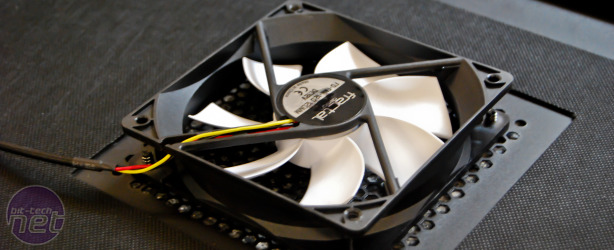
Cooling with One Fan
Adding a single fan to the case makes things a little more interesting. Again, this is less fans than you’re likely to get on a decent case, but some budget cases only come with one fan, so we thought it’d be worth investigating.We should quickly note that from here on in, unless otherwise stated, we tested with the fan grilles open (i.e. without the blanking plates in place). This is partly due to expediency (we didn’t have time to try every combination with and without blanking plates) and partly because of the findings on the previous page - if you have spare fan mounts and you’re after low temperatures, we’d recommend you leave the unobstructed. We’d also like to point out that fans were mounted in their traditional orientation (intake at front/side/floor, exhaust at rear/roof) unless otherwise stated.
The graph below makes for interesting reading then as it shows that the most effective position for a single fan is in the side panel. This is intriguing as typically, if you only had a single fan, you’d probably be tempted to mount it as either a front intake or a rear exhaust as these are the traditional positions for a single fan.
Clearly though, at least in this case, you seem to get better value from a side panel fan as it matches the roof (B) and rear fans for CPU cooling while also offering better GPU and chipset cooling. The one caveat here of course is that side panel mounts rarely come with dust filters, so you’ll be drawing more dust into your case than if you used a front intake or a rear exhaust position for the fan.
A further interesting area was the front (F) roof mount in the Define R3 case - something which many cases have these days. This sits just in front of the CPU cooler and, when left empty, provides a nice intake for the cooler to pull air in through as it pleases. Fitting it with a fan was problematic though as the fan actively pushed air past the CPU cooler, down into the case towards the back of the graphics card - something which lead to this setup returning poorer results than we’d expected, especially for CPU cooling. As a result we’d generally advise leaving this fan mount, if your case has one, open and without a fan in it.
If you don’t fancy using your only fan as a side intake (or if you don’t have a side mount) then we can see that, in general, and with only one fan, you’re better off getting hot air out of the case than pushing cool air in. This is because a rear or roof exhaust generally offers superior CPU cooling and comparable GPU cooling to a front intake fan.

The humble side panel fan proved very effective, but beware, it's not commonly fitted with a dust filter
We can also see that there is very little difference between the two front intakes. The upper of the two (U) offers fractionally better GPU cooling than the lower (L), but the difference is so small that for all intents and purposes, if you want a front intake, it doesn’t matter which of the two mounts you use.
The final thing to take away from this page is the chipset temperatures. We saw far more variation in this reading than the CPU or GPU temperature readings, most likely because its passively cooled rather than actively cooled so relies entirely on the case fans for its cooling. The side panel fan was, unsurprisingly, excellent at cooling the chipset and the motherboard in general as it was blowing cool air directly down onto the motherboard. The floor intake was also good here, though it lacked CPU cooling ability.

MSI MPG Velox 100R Chassis Review
October 14 2021 | 15:04








Want to comment? Please log in.